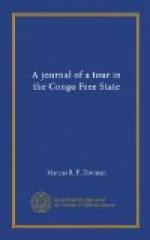As we approach nearer, the northern point resolves itself into the extremity of a peninsula, for one branch of the river turns northward thus leaving a strip of land a few hundred yards wide. We pass through the mouth of the river, thread our way between several buoys, turn up this northern channel and arrive at an anchorage in which eight or nine small ships are riding. As we take up our position a boat leaves the shore flying the Congo Flag, a blue ground with a golden star in the centre. Soon after we go ashore in a dug out. propelled by Kru boys to the town of Banana, which is built on this sandy peninsula and is thus guarded by sharks on one side and crocodiles on the other. We land at a wooden pier used chiefly for loading canoes. On each side are magnificent palms, some being more than fifty feet high and all bearing many cocoa nuts at this season about half ripe. These palms are not indigenous, but flourish here. The main highway of Banana is a path of clean yellow sand about ten feet wide, shaded by an avenue of these palms and crosses at intervals small tidal streams by rustic wooden bridges. Many tropical trees and shrubs grow on each side of the avenue, and in the bright sunshine the whole forms a very beautiful picture. It is unfortunate that the effect reminds one somewhat forcibly of a transformation scene of a pantomime and thus appears artificial although in reality, it is absolutely natural. The resemblance is still further strengthened by the numerous ladies of the ballet who leisurely stroll along clothed in nature’s ebony black. No one seems to know the origin of the name of the town, for the Banana palm is not found here at all.
At the extreme end of the point, and extending inwards for several hundred yards, are the grounds of the Dutch Trading Company, which has been established here for more than fifty years and ships many of the products of the country. The wooden sheds painted white are very picturesque amid the vivid green foliage. Beyond this area is the house of Dr. Carre, the Commissaire of the District of Banana, which like all the other houses in the town is raised on piles above the level of the sand, for the double purpose of ensuring a current of air beneath and of keeping it dry when the peninsula is flooded. It faces the sea and behind is a small garden in which are many meteorological instruments. Among these are an anemometer slowly revolving in the light air, maximum and minimum bulbs in the shade, on the ground and beneath it, a most ingenious sun dial, and a heliometer. Walking inland along the central avenue, we pass some native shops, one of which bears the interesting name of Williams Brothers. In many of the verandahs, native women wrapped in highly coloured cloths but with bare feet and legs, are working sewing machines or tending their children. Further on is a space laid out in regular squares, in each of which is a well built wooden house raised on piles, and an ornamental




